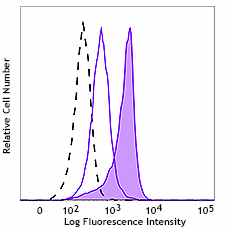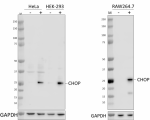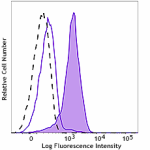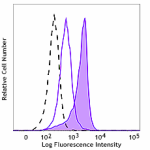- Clone
- 9C8/CHOP (See other available formats)
- Regulatory Status
- RUO
- Other Names
- DDIT3, GADD153
- Isotype
- Mouse IgG2b, κ
- Ave. Rating
- Submit a Review
- Product Citations
- publications

-

THP-1 cells untreated (negative control, open histogram) or treated with 2 µg/mL Tunicamycin for 8 hours (positive control, filled histogram) were fixed and permeabilized using True-Nuclear™ Transcription Factor Buffer Set (Cat. No. 424401) and intracellularly stained with PE anti-CHOP (clone 9C8/CHOP), or PE mouse IgG2b, κ isotype control (open histogram, dashed line)(representative histogram for untreated and treated cells)(Cat. No. 401207).
| Cat # | Size | Price | Save |
|---|---|---|---|
| 948705 | 25 tests | ¥42,680 | |
| 948706 | 100 tests | ¥84,040 |
When unfolded proteins accumulate in the ER lumen, multiple unfolded protein response (UPR) pathways become activated, including PERK, ATF6, and IRE1α, all of which transcriptionally reprogram the flux of proteins through the ER. When these quality control mechanisms fail to restore ER homeostasis, sustained stress results in the induction of CHOP, a pro-apoptotic transcription factor that negatively regulates expression of BCL2 and increases expression of BIM and TNFS10RB. One mechanism cancer cells exploit to adapt to harsh conditions of the tumor microenvironment is through upregulation of UPR pathways. Thus, understanding the molecular mechanisms that govern the switch from adaptation to apoptosis is of great therapeutic interest.
Product DetailsProduct Details
- Verified Reactivity
- Human, Mouse
- Antibody Type
- Monoclonal
- Host Species
- Mouse
- Immunogen
- Partial recombinant human CHOP protein
- Formulation
- Phosphate-buffered solution, pH 7.2, containing 0.09% sodium azide and BSA (origin USA)
- Preparation
- The antibody was purified by affinity chromatography and conjugated with PE under optimal conditions.
- Concentration
- Lot-specific (to obtain lot-specific concentration and expiration, please enter the lot number in our Certificate of Analysis online tool.)
- Storage & Handling
- The antibody solution should be stored undiluted between 2°C and 8°C, and protected from prolonged exposure to light. Do not freeze.
- Application
-
ICFC - Quality tested
- Recommended Usage
-
Each lot of this antibody is quality control tested by intracellular immunofluorescent staining with flow cytometric analysis. For flow cytometric staining, the suggested use of this reagent is 5 µL per million cells in 100 µL staining volume or 5 µL per 100 µL of whole blood. It is recommended that the reagent be titrated for optimal performance for each application.
- Excitation Laser
-
Blue Laser (488 nm)
Green Laser (532 nm)/Yellow-Green Laser (561 nm)
- Application Notes
-
This clone failed to detect CHOP in human small intestine.
For ICC testing, we do not recommend methanol only as a fixation-permeabilization step due to poor CHOP staining. We recommend 4% PFA fixation with either Triton X-100 or methanol permeabilization. - RRID
-
AB_2936754 (BioLegend Cat. No. 948705)
AB_2936754 (BioLegend Cat. No. 948706)
Antigen Details
- Structure
- CHOP is a 169 amino acid protein with a predicted molecular weight of 19 kD.
- Distribution
-
Expressed in cells and tissue undergoing ER stress/Nucleus
- Function
- Transcription Factor
- Biology Area
- Apoptosis/Tumor Suppressors/Cell Death, Cell Biology, Protein Misfolding and Aggregation, Transcription Factors
- Antigen References
-
1. Yamaguchi, et al. 2004. J. Biol. Chem. 279: 45495
2. Oyadomari, et al. 2004. Cell Death Differ. 11:381.
3. Puthalakath H, et al. 2007. Cell. 129: 1337. - Gene ID
- 1649 View all products for this Gene ID
- UniProt
- View information about CHOP on UniProt.org
Related Pages & Pathways
Pages
Related FAQs
- What type of PE do you use in your conjugates?
- We use R-PE in our conjugates.
Other Formats
View All CHOP Reagents Request Custom Conjugation| Description | Clone | Applications |
|---|---|---|
| Purified anti-CHOP Antibody | 9C8/CHOP | WB,ICFC,ICC |
| Alexa Fluor® 647 anti-CHOP | 9C8/CHOP | ICFC |
| PE anti-CHOP | 9C8/CHOP | ICFC |
Compare Data Across All Formats
This data display is provided for general comparisons between formats.
Your actual data may vary due to variations in samples, target cells, instruments and their settings, staining conditions, and other factors.
If you need assistance with selecting the best format contact our expert technical support team.
-
Purified anti-CHOP Antibody

Whole cell extracts (15 µg protein) from HeLa and HEK-293, a... 
ICC staining of purified anti-CHOP antibody (clone 9C8/CHOP)... 
HeLa cells treated with 2.0 µg/mL tunicamycin for 8 hours (f... -
Alexa Fluor® 647 anti-CHOP

THP-1 cells untreated (negative control, open histogram) or ... -
PE anti-CHOP

THP-1 cells untreated (negative control, open histogram) or ...












Follow Us